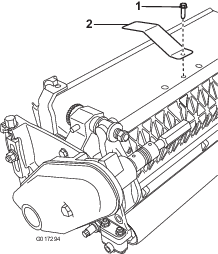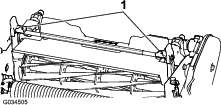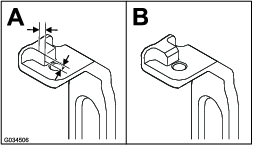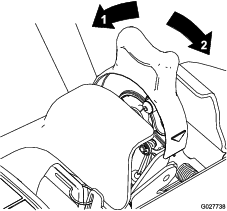| Maintenance Service Interval | Maintenance Procedure |
|---|---|
| Before each use or daily |
|
Introduction
This machine is a walk-behind, reel-blade lawn mower intended to be used by professional, hired operators in commercial applications. It is primarily designed for cutting grass on well-maintained turf. Using this product for purposes other than its intended use could prove dangerous to you and bystanders.
Read this information carefully to learn how to operate and maintain your product properly and to avoid injury and product damage. You are responsible for operating the product properly and safely.
Visit www.Toro.com for product safety and operation training materials, accessory information, help finding a dealer, or to register your product.
Whenever you need service, genuine Toro parts, or additional information, contact an authorized Toro distributor and have the model and serial numbers of your product ready. The model and serial numbers are located on a plate on the rear frame. Write the numbers in the space provided.
Important: With your mobile device, you can scan the QR code (if equipped) on the serial number decal to access warranty, parts, and other product information.
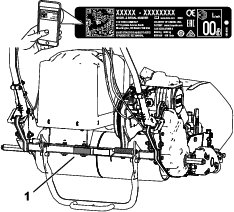
This manual identifies potential hazards and has safety messages identified by the safety-alert symbol (Figure 2), which signals a hazard that may cause serious injury or death if you do not follow the recommended precautions.

This manual uses 2 words to highlight information. Important calls attention to special mechanical information and Note emphasizes general information worthy of special attention.
This product complies with all relevant European directives; for details, please see the separate product specific Declaration of Conformity (DOC) sheet.
Warning
CALIFORNIA
Proposition 65 Warning
The power cord on this product contains lead, a chemical known to the State of California to cause birth defects or other reproductive harm. Wash hands after handling.
Battery posts, terminals, and related accessories contain lead and lead compounds, chemicals known to the State of California to cause cancer and reproductive harm. Wash hands after handling.
Use of this product may cause exposure to chemicals known to the State of California to cause cancer, birth defects, or other reproductive harm.
Safety
This machine has been designed in accordance with ANSI B71.4-2017, IEC 60335-1: 2012, and IEC 60335-2-77: 2010 and meets these standards when you complete the setup instructions.
General Safety
This product is capable of amputating hands and feet and of throwing objects.
-
Read and understand the contents of this Operator’s Manual before starting the machine.
-
Use your full attention while operating the machine. Do not engage in any activity that causes distractions; otherwise, injury or property damage may occur.
-
Do not put your hands or feet near moving components of the machine.
-
Do not operate the machine without all guards and other safety protective devices in place and functioning properly on the machine.
-
Keep bystanders and children out of the operating area. Never allow children to operate the machine.
-
Shut off the machine, remove the key (if equipped), and wait for all movement to stop before you leave the operator’s position. Allow the machine to cool before adjusting, servicing, cleaning, or storing it.
Improperly using or maintaining this machine can result in injury.
To reduce the potential for injury, comply with these safety instructions
and always pay attention to the safety-alert symbol  , which means
Caution, Warning, or Danger—personal safety instruction. Failure
to comply with these instructions may result in personal injury or
death.
, which means
Caution, Warning, or Danger—personal safety instruction. Failure
to comply with these instructions may result in personal injury or
death.
Safety and Instructional Decals
 |
Safety decals and instructions are easily visible to the operator and are located near any area of potential danger. Replace any decal that is damaged or missing. |











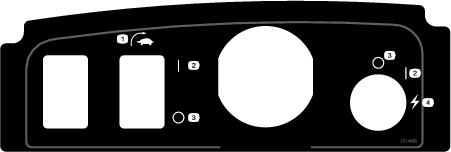


Setup
Note: Determine the left and right sides of the machine from the normal operating position.
Installing the Target Plate
Preparing the Cutting Unit
Installing the Cutting Unit to the Traction Unit
Parts needed for this procedure:
| Bolt (3/8 x 3/4 inch) | 2 |
Note: To install the weight rod onto your machine, refer to the installation instructions in your cutting unit Operator’s Manual.
-
Place the mower on its drums on a level surface.
-
Lower the kickstand and push in the locking pin to lock the kickstand in the SERVICE position (Figure 6). Allow the machine to rest on the locked kickstand.
Note: Place the kickstand in the SERVICE position whenever you remove the cutting unit. This kickstand position keeps the machine from tipping backward onto the handle.
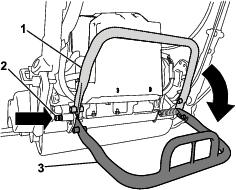
-
Push the cutting unit under the traction unit and to the left to engage the transmission coupling (Figure 7).
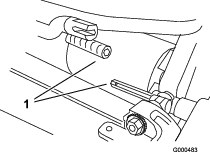
-
Maneuver the machine frame forward until it engages the cutting unit pivot arms Figure 8.
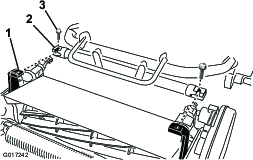
-
Secure the machine frame to the cutting unit pivot arms with the 2 bolts (3/8 x 3/4 inch) (Figure 8).
-
Move the kickstand to the STORAGE position by releasing the locking pin and allowing the kickstand to rotate up.
-
Set the cutting-unit height of cut; refer to your cutting unit Operator’s Manual.
Installing the Handle Retainers
Parts needed for this procedure:
| Handle retainer | 2 |
| Hairpin cotter | 2 |
-
While supporting the handle, remove the cable ties that secure the handle clamps to the side plates (Figure 9).
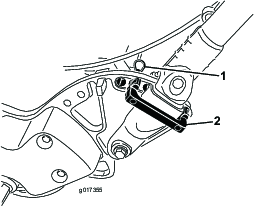
-
Pivot the handle to the desired operating position and insert a handle retainer over the handle clamp and into the matching holes in the side plate (Figure 9).
-
Secure the clamp in position with a hairpin cotter (Figure 9).
-
Repeat the procedure on the opposite side of the handle.
-
Adjust the handle height to the desired position; refer to Adjusting the Handle Height.
Note: The machine is shipped with the handle adjusted to the lowest position. The machine is traditionally operated with the handle telescoped out to its maximum height.
Adjusting the EZ-Turn Sensor
-
Ensure that the machine is on a flat, level surface with the traction drum on the ground.
-
Loosen the jam nuts on the sensor and adjust the sensor so that 1 thread is visible past the lower jam nut (Figure 10).
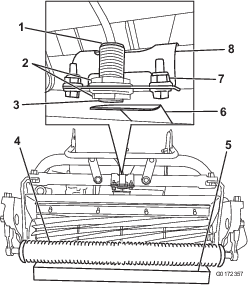
-
Tighten the jam nuts to secure the sensor.
-
Place a 3.8 cm (1-1/2 inches) block under the front cutting unit roller (Figure 10).
-
Loosen the fasteners that secure the sensor bracket to the frame (Figure 10).
-
Start the machine; refer to Starting the Machine.
-
Set the EZ-Turn switch to the ON position.
-
Rotate the sensor bracket toward the target plate until the light on top of the sensor illuminates (Figure 10). If the light was already illuminated, rotate it away from the target plate until it goes out and then reverse direction until it illuminates again.
-
Tighten the bracket fasteners.
-
Remove the block from under the roller and place the machine on the kickstand.
-
Ensure that the target plate does not contact the grass shield.
Note: If the plate does contact the shield, loosen the bracket fasteners and rotate the switch up until the plate is no longer touching the shield.
-
Turn off the machine.
Installing the Transport Wheels
Parts needed for this procedure:
| Transport wheels—Transport Wheel Kit (Model No. 04123 [Optional]) | 2 |
-
Use your foot to push the center of the kickstand loop down and pull up on the lower handle support until the kickstand has rotated forward and over center (Figure 11).
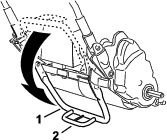
-
Press the wheel locking clip toward the center of wheel and slide the wheel onto the hex shaft (Figure 12).
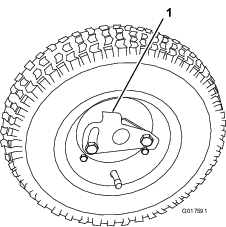
-
Rotate the wheel back and forth until it fits onto the axle and the locking clip is secured in the groove on the axle shaft.
-
Repeat the procedure on the opposite side of the machine.
-
Inflate the tires to 83 to 103 kPa (12 to 15 psi).
-
Carefully lower the machine off of the kickstand by pushing forward slowly or by lifting the lower handle support, allowing the kickstand to spring back to the STORAGE position.
Installing the Production-Year Decal
Parts needed for this procedure:
| Production-year decal | 1 |
If you use this machine in a country that complies to CE standards, apply the production-year decal near the serial plate; refer to Figure 13.
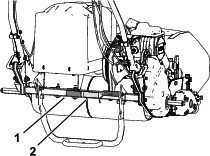
Installing the Grass Basket
Parts needed for this procedure:
| Grass basket | 1 |
-
Grasp the basket by the handle.
-
Guide the basket lip between the cutting unit side plates and over the front roller (Figure 14).
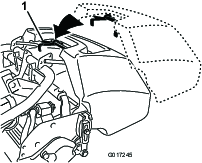
-
Install the basket hooks over the frame loop (Figure 14).
Important: If you ever drop the basket, examine the pitch-arm contact points near the lower lip of the basket for damage (Figure 15). Straighten them before using the basket.Using the basket with bent pitch-arm contact points may cause contact between the basket and cutting unit, causing undesired noise and/or damage to the basket and cutting unit.
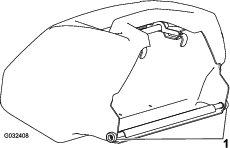
Mounting the Battery Charger on a Wall
You can mount the charger on a wall using the wall-mount key holes cut into the back of the unit. Use screws that have a 6 mm (1/4 inch) diameter shaft and a head diameter of 11 mm (0.45 inch).
Important: Survey your work area and determine a location that best meets the criteria for safe and effective operation of the charger.
Breaking in the Machine
Only 8 hours of mowing operation is required for the break-in period.
Since the first hours of operation are critical to future dependability of the machine, monitor the machine functions and performance closely so that minor difficulties, which could lead to major problems, are noted and can be corrected. Inspect the machine frequently during break-in for signs of loose fasteners or any other malfunction.
Product Overview
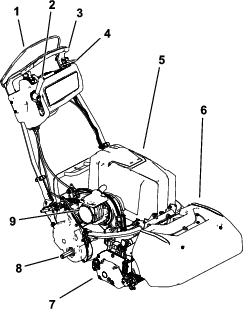
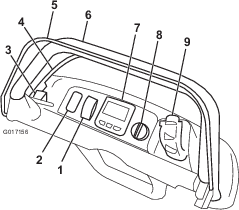
EZ-Turn Switch
The EZ-Turn switch (Figure 17) enables or disables the EZ-Turn feature. The EZ-Turn feature automatically slows the machine whenever you raise the cutting unit off the ground during mowing. This allows you to make the turns at the end of each mowing pass at a slower speed. You can use the switch at any time, even while mowing.
This feature only reduces the ground speed when the reel is engaged and lifted off the ground. It has no effect on ground speed when the reel is disengaged. If this feature is activated while mowing and you turn off the reel, the machine will speed up. If you are mowing at a slow speed already, the EZ-Turn feature will not slow the machine on a turn.
Service Brake
The service brake (Figure 18) is located on the left front side of the handle. Pulling back the lever applies the service brake.
You must disengage the brake before you engage the traction drive. If you operate the machine with the brake engaged, the machine moves, but with a high resistance and increased power consumption.
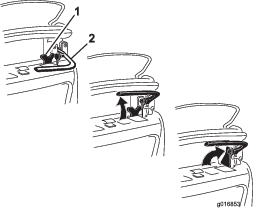
Parking-Brake Latch
Use the parking-brake latch (Figure 18) with the service brake. Rotate the parking-brake latch toward the brake handle to hold the service brake in place. Pull the brake lever to release.
Note: You cannot move the traction-control lever while the latch is engaged.
Operator-Presence Control (OPC)
You must engage the operator-presence control (Figure 17) before you engage the traction lever. If you release the OPC during operation, the traction lever returns to neutral and the machine continues to run.
InfoCenter LCD Display
The InfoCenter LCD display shows information about your machine and battery pack, such as the current battery charge, speed, diagnostics information, and more (Figure 17).
For more information, refer to Using the InfoCenter LCD Display.
Key Switch
The key switch (Figure 17) has 2 positions: OFF and RUN. With the brake off and the traction drive disengaged, move the switch to the RUN position until the InfoCenter display lights up. Turn it to the OFF position and remove the key to turn off the machine.
Speed Control
Traction and Reel-Drive Engagement Lever
The traction and reel-drive engagement lever (Figure 20) is located on the front right side of the control panel.
To transport the machine, the lever has 2 positions: NEUTRAL and FORWARD. Pushing the lever to the traction—FORWARD (transport) position or the traction—FORWARD and reel drive—ENGAGE position engages the traction drive (Figure 20).
Note: To move the lever, you must first engage the operator-presence control.
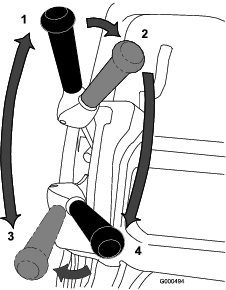
To operate the reel, the lever has 2 positions: ENGAGE and DISENGAGE. Move the top of the lever to the left, then forward to the traction—FORWARD and reel drive—ENGAGE position to engage the reel and begin mowing. Push the lever to the right to the traction—FORWARD (transport) position to disengage the reel and continue forward motion or pull back on it to the traction—NEUTRAL and reel drive—DISENGAGE position to disengage both the reel and the traction drive (Figure 20).
Note: If you release the operator-presence control, the lever returns to neutral and the machine stops.
Automatic-Motor Brake
The machine is equipped with an automatic-motor brake that prevents it from rolling when the machine is shut off. The motor brake is on whenever the traction drive is in the NEUTRAL position or you move the speed control to the ZERO position, except in the following circumstances:
-
When the machine is turned off, use the parking-brake latch to ensure that the service brake is consistently engaged.
-
When you start the machine with the key switch, the motor brake is initially disengaged. After driving the machine, the motor brake functions normally.
-
If you move the speed control to zero speed while the reels are engaged (i.e., while mowing), the brake does not engage. This feature allows you to move to the speed control to the ZERO position while mowing and pull the machine rearward to make course corrections.
Kickstand
The kickstand (Figure 22) is mounted to the rear of the machine. Use the kickstand when you install or remove the transport wheels or the cutting unit.
-
To use the kickstand to install the transport wheels, lower the kickstand to the ground and step down on the loop while pulling up and back on the lower-center handle (Figure 21).
Caution
The machine is heavy and may cause back strain if lifted improperly.
Put your foot pressure down on the kickstand loop and use only the lower-center handle to raise the machine. Attempting to raise the machine onto the kickstand any other way may cause injury.
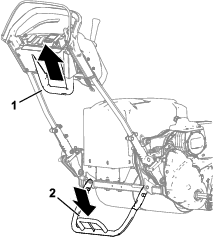

-
To prevent the machine from tipping backward when removing the reel, lower the kickstand and push in the locking pin to lock it in the SERVICE position (Figure 23).

Note: Specifications and design are subject to change without notice.
| Overall width | 90.1 cm (35-1/2 inches) | |
| Overall height | 104.8 cm (41–1/4 inches) | |
| Overall length (with basket) | 152.4 cm (60 inches) | |
| Net weight (with 11-blade cutting unit and grass basket) | 132.9 kg (293 lb) | |
| Width of cut | 53.3 cm (21 inches) | |
| Height of cut | 1.5 to 7.5 mm (1/16 to 19/64 inches) with Micro-Cut bedknife | |
| Clip frequency | Adjustable (refer to Cutting Unit Operator’s Manual) | |
| Voltage | 48 V |
| Current | DC ( ) ) |
| Amp Hours | 25.6 AH |
| IP Rating | IP65 |
Attachments/Accessories
A selection of Toro approved attachments and accessories is available for use with the machine to enhance and expand its capabilities. Contact your Authorized Service Dealer or authorized Toro distributor or go to www.Toro.com for a list of all approved attachments and accessories.
To ensure optimum performance and continued safety certification of the machine, use only genuine Toro replacement parts and accessories. Replacement parts and accessories made by other manufacturers could be dangerous, and such use could void the product warranty.
Operation
Note: Determine the left and right sides of the machine from the normal operating position.
Before Operation
Before Operation Safety
General Safety
-
Never allow children or untrained people to operate or service the machine. Local regulations may restrict the age of the operator. The owner is responsible for training all operators and mechanics.
-
Become familiar with the safe operation of the equipment, operator controls, and safety signs.
-
Shut off the machine, remove the key (if equipped), and wait for all movement to stop before you leave the operator’s position. Allow the machine to cool before adjusting, servicing, cleaning, or storing it.
-
Know how to stop the machine and shut off the machine quickly.
-
Check that operator-presence controls, safety switches, and safety protective devices are attached and functioning properly. Do not operate the machine unless they are functioning properly.
-
Inspect the area where you will use the machine and remove all objects that the machine could throw.
Performing Daily Maintenance
Perform the daily maintenance procedures; refer to Daily Maintenance Checklist.
Setting the Machine to Match Turf Conditions
Use the following table to set the machine to match turf conditions.
| Bedbars: Standard and Optional (Flex/eFlex 2120 Machines) | |||
| Part Number | Description | Aggressiveness | Comments |
| 106-2468-01 | Non-Aggressive | Less | Red, Standard |
| 99-3794-03 | Aggressive | More | Black |
| Bedbars: Standard and Optional (Flex/eFlex 1820 Machines) | |||
| 110-2282-01 | Non-Aggressive | Less | Red, Standard |
| 110-2281-03 | Aggressive | More | Black |
| Bedknives: Standard and Optional (Flex/eFlex 2120 Machines) | |||
| Part Number | Description | Height-of-cut Range | Comments |
| 115-1880 | Microcut-EdgeMax | 1.6 to 3.2 mm (0.062 to 0.125 inch) | Standard |
| 93-4262 | Microcut | 1.6 to 3.2 mm (0.062 to 0.125 inch) | |
| 108-4303 | Extended Microcut | 1.6 to 3.2 mm (0.062 to 0.125 inch) | Less aggressive |
| 115-1881 | Tournament- EdgeMax | 3.2 to 6.4 mm (0.125 to 0.25 inch) | |
| 93-4263 | Tournament | 3.2 to 6.4 mm (0.125 to 0.25 inch) | |
| 108-4302 | Extended Tournament | 3.2 to 6.4 mm (0.125 to 0.25 inch) | Less aggressive |
| 93-4264 | Low Cut | 6.4 mm (0.25 inch) and up | |
| Bedknives: Standard and Optional (Flex/eFlex 1820 Machines) | |||
| 117-1530 | Microcut-EdgeMax | 1.6 to 3.2 mm (0.062 to 0.125 inch) | Standard |
| 98-7261 | Microcut | 1.6 to 3.2 mm (0.062 to 0.125 inch) | |
| 110-2300 | Extended Microcut | 1.6 to 3.2 mm (0.062 to 0.125 inch) | Less aggressive |
| 98-7260 | Tournament | 3.2 to 6.4 mm (0.125 to 0.25 inch) | |
| 117-1532 | Tournament- EdgeMax | 3.2 to 6.4 mm (0.125 to 0.25 inch) | |
| 110-2301 | Low Cut | 6.4 mm (0.25 inch) and up | |
| Rollers (Flex/eFlex 2120 Machines) | |||
| Part Number | Description | Diameter/Material | Comments |
| 04255 | Narrow Wiehle | 6.4 cm (2.5 inches)/Aluminum | Narrow spaced grooves |
| 04256 | Wide Wiehle | 6.4 cm (2.5 inches)/Aluminum | More penetration, wide spaced grooves |
| 04257 | Full Roller | 6.4 cm (2.5 inches)/Steel | Least penetration |
| 04258 | Narrow Wiehle—Long | 6.4 cm (2.5 inches)/Aluminum | More edge support; 4.3 cm (1.7 inches) longer |
| 04267 | Paspalum | 6.4 cm (2.5 inches)/Aluminum | Less penetration, softened narrow spaced grooves |
| 115-7356 | Rear Roller | 5.1 cm (2.0 inches)/Aluminum | Standard rear |
| 120-9595 | Rear Roller | 5.1 cm (2.0 inches)/Steel | Steel rear |
| Rollers (Flex/eFlex 1820 Machines) | |||
| 120-9607 | Narrow Wiehle | 6.4 cm (2.5 inches)/Aluminum | Narrow spaced grooves |
| 120-9609 | Wide Wiehle | 6.4 cm (2.5 inches)/Aluminum | More penetration, wide spaced grooves |
| 120-9611 | Full Roller | 6.4 cm (2.5 inches)/Steel | Least penetration |
| 121-4681 | Narrow Wiehle—Long | 6.4 cm (2.5 inches)/Aluminum | More edge support; 4.3 cm (1.7 inches) longer |
| 120-9605 | Rear Roller | 5.1 cm (2.0 inches)/Aluminum | Standard rear |
Adjusting the Handle Height
Note: The machine is shipped with the handle adjusted to the lowest position. The machine is normally operated with the handle telescoped out to its maximum height.
-
Loosen the 3 carriage bolts and nuts securing each side of the handle in the handle clamps (Figure 24).
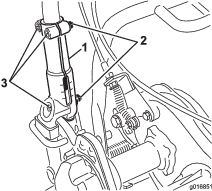
-
Pull up on the handle slowly and evenly on each side until it is in the desired operating position.
-
Tighten the carriage bolts and nuts to lock the adjustment.
Adjusting the Handle Angle
Adjusting the Throttle Control
-
Remove the console cover.
-
Loosen the 2 fasteners securing the throttle control (Figure 26).
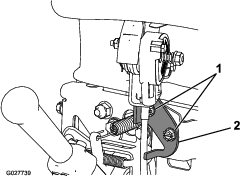
-
Adjust the throttle control to the desired position.
-
Tighten the throttle-control fasteners.
-
Install the previously removed console cover.
Checking the Operation of the Interlock Switches
Caution
If the safety interlock switches are disconnected or damaged the machine could operate unexpectedly, causing personal injury.
-
Do not tamper with the interlock switches.
-
Check the operation of the interlock switches daily and replace any damaged switches before operating the machine.
Checking the Operator-Presence Control (OPC) Interlock
-
Push the kickstand down with your foot and pull up on the handle support until the kickstand has rotated forward, over center.
-
Start the machine.
-
With the OPC released, attempt to engage the traction lever (Figure 27). The traction lever should not engage. If the traction lever engages, the interlock system needs service. Correct the problem before operating the machine; refer to Servicing the Traction Interlock Switch.
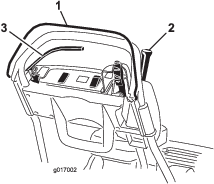
-
With the OPC pressed and the traction lever engaged, release the OPC (Figure 27). The traction lever should disengage. If the traction lever does not disengage, the interlock system needs service. Correct the problem before operating the machine. Refer to Servicing the Traction Interlock Switch.
-
With the OPC pressed and the shift lever moved to the left, engage the traction and reel drive, release the OPC (Figure 27). The traction lever should disengage. If the traction lever does not disengage, the interlock system needs service. Correct the problem before operating the machine; refer to Servicing the Traction Interlock Switch or Adjusting the Reel Control.
-
With the OPC pressed and the shift lever moved to the left, engage the traction and reel drive. Move the shift lever to the right to disengage the reel drive (Figure 16). The reel drive should disengage. If the reel drive does not disengage, the interlock system needs service. Correct the problem before operating the machine; refer to Servicing the Traction Interlock Switch.
-
Carefully lower the machine off the kickstand.
Checking the Traction-Interlock Switch
-
Ensure that the kickstand is down.
-
Press the OPC and engage the traction lever (Figure 27)
-
Use the key switch to start the machine. The InfoCenter LCD display lights up and display a message warning that the traction lever is engaged. If this warning does not appear, the interlock switch needs service. Correct the problem before operating the machine; refer to Servicing the Traction Interlock Switch.
-
Turn off the machine and return the traction lever to the NEUTRAL position.
Checking the Brake-Interlock Switch
-
Ensure that the kickstand is down.
-
With the machine on and the service brake engaged (not the parking–brake latch) with moderate force, press the OPC and engage the traction lever (Figure 16). The motor should labor to overcome the brake without producing errors on the InfoCenter LCD display. It may display a high power consumption advisory (smaller battery with a lightning bolt). If you get any other advisory, correct the problem before operating the machine.
-
With the machine on, engage the parking-brake latch, press the OPC, and engage the traction lever (Figure 16 and Figure 17). The motor should not run and you should get an advisory on the InfoCenter panel. If not, the interlock switch needs service. Correct the problem before operating the machine; refer to Servicing the Brake-Interlock Switch.
-
Turn off the machine and return the traction lever to the NEUTRAL position.
-
Carefully lower the machine off the kickstand.
Transporting the Machine to the Job Site
Transporting the Machine Using Transport Wheels
Use the transport wheels to transport the machine a shorter distance.
-
Install the transport wheels; refer to Installing the Transport Wheels.
-
Ensure that the traction and reel-drive lever is in the NEUTRAL position.
-
Ensure that the speed control is set to ZERO.
-
Start the machine; refer to Starting the Machine
-
Tip the front of the machine up, gradually move the traction control to the FORWARD position, and use the speed control to slowly increase the machine speed.
-
Adjust the speed control to operate the mower at the desired ground speed and transport the machine to the desired destination.
Transporting the Machine Using a Trailer
Use a trailer to transport the machine a considerable distance. Use caution while loading and unloading the machine onto the trailer.
-
Carefully drive the machine onto the trailer.
-
Shut off the machine, engage the service brake, and use the parking-brake latch to hold the service brake in place.
-
Securely fasten the machine to the trailer.
Note: You can use the Toro Trans Pro trailer to transport the machine. For instructions on loading the trailer, refer to your trailer Operator’s Manual.
Important: Ensure that the machine is shut off while you transport it on a trailer, as damage can occur to the machine if it is on during transportation.
During Operation
During Operation Safety
General Safety
-
The owner/operator can prevent and is responsible for accidents that may cause personal injury or property damage.
-
Wear appropriate clothing, including eye protection; long pants; substantial, slip-resistant footwear; and hearing protection. Tie back long hair and do not wear loose clothing or loose jewelry.
-
Do not operate the machine while ill, tired, or under the influence of alcohol or drugs.
-
Use your full attention while operating the machine. Do not engage in any activity that causes distractions; otherwise, injury or property damage may occur.
-
Before you turn on the machine, ensure that all drives are in neutral, the parking brake is engaged, and you are in the operating position.
-
Keep bystanders and children out of the operating area. If co-workers must be present, use caution and ensure that the grass basket is installed on the machine.
-
Operate the machine only in good visibility to avoid holes or hidden hazards.
-
Do not operate the machine when there is the risk of lightning.
-
Use care when mowing on wet grass. Poor footing could cause a slip-and-fall accident.
-
Keep your hands and feet away from the cutting unit.
-
Look behind and down before backing up to be sure of a clear path.
-
Use extreme caution when reversing or pulling the machine toward you.
-
Use care when approaching blind corners, shrubs, trees, or other objects that may obscure your vision.
-
Stop the cutting unit whenever you are not mowing.
-
Disengage the drive to the cutting unit and shut off the machine before adjusting the height of cut.
-
Never leave a running machine unattended.
-
Before you leave the operator’s position, do the following:
-
Park the machine on a level surface.
-
Disengage the cutting unit(s).
-
Engage the parking brake.
-
Shut off the machine and remove the key (if equipped).
-
Wait for all movement to stop.
-
-
Shut off the machine before emptying the basket.
-
Shut off the machine and disengage the drive to the cutting unit in the following situations:
-
Before charging
-
Before clearing blockages
-
Before removing the grass basket
-
Before checking, cleaning, or maintaining the cutting unit
-
After striking a foreign object or if an abnormal vibration occurs. Inspect the cutting unit for damage and make repairs before starting and operating the machine
-
Before leaving the operating position
-
-
Use only accessories and attachments approved by The Toro® Company.
Slope Safety
-
Slopes are a major factor related to loss of control and rollover accidents, which can result in severe injury or death. You are responsible for safe slope operation. Operating the machine on any slope requires extra caution. Before using the machine on a slope, do the following:
-
Review and understand the slope instructions in the manual and on the machine.
-
Evaluate the site conditions of the day to determine if the slope is safe for machine operation. Use common sense and good judgment when performing this evaluation. Changes in the terrain, such as moisture, can quickly affect the operation of the machine on a slope.
-
-
Operate across slopes, never up and down. Avoid operation on excessively steep or wet slopes. Poor footing could cause a slip-and-fall accident.
-
Identify hazards at the base of the slope. Do not operate the machine near drop-offs, ditches, embankments, water, or other hazards. The machine could suddenly roll over if a wheel goes over the edge or the edge collapses. Keep a safe distance between the machine and any hazard. Use a handheld tool to operate in these areas.
-
Avoid starting, stopping, or turning the machine on slopes. Avoid making sudden changes in speed or direction; turn slowly and gradually.
-
Do not operate a machine under any conditions where traction, steering, or stability is in question. Be aware that operating the machine on wet grass, across slopes, or downhill may cause the machine to lose traction. Loss of traction to the drive may result in sliding and a loss of braking and steering. The machine can slide even if you stop the drive.
-
Remove or mark obstacles such as ditches, holes, ruts, bumps, rocks, or other hidden hazards. Tall grass can hide obstacles. Uneven terrain could overturn the machine.
-
If you lose control of the machine, step away from the direction of travel of the machine.
-
Always keep the machine in gear when going down slopes. Do not coast downhill (applicable only to gear-drive units).
Starting the Machine
-
Ensure that the T-handle connector on the main wire harness is connected to the main power supply connector (Figure 33).
-
Ensure that the traction and reel drive lever is in the NEUTRAL position; refer to Figure 20.
-
Insert the key into the key switch, turn the switch to the RUN position and ensure that the InfoCenter LCD display lights up.
Shutting Off the Machine
-
Move the traction and reel drive lever to the NEUTRAL position.
-
Turn the key switch to the OFF position and remove the key.
Releasing the Transmission
If the machine becomes disabled with the motor brake on, you can disengage the drum from the transmission to allow the machine to be maneuvered.
-
On the right rear corner of the machine, locate the traction engage/disengage lever next to the drive housing drum (Figure 28).
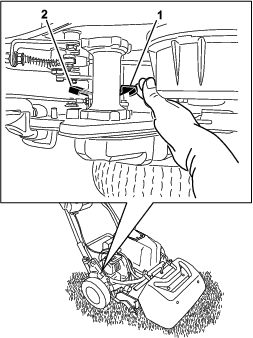
-
Rotate the lever rearward to disengage the transmission from the drum.
Important: Push the lever from the front to prevent your hand from being struck by the spring loaded lever.
-
Move the machine as needed
Important: If possible, do not tow the machine. If it is absolutely necessary, do not tow at any speed greater than 4.8 kph (3 mph); always disengage the transmission from the drum. Failing to do so will likely cause damage to the machine, especially the electrical components.
-
When finished, rotate the lever forward to engage the transmission to the drum.
Note: The service brake is still operational with the transmission disengaged from the drum.
Using the InfoCenter LCD Display
The InfoCenter LCD display shows information about your machine such as the current battery charge, the speed, various diagnostics, and other information about the machine and the battery pack. Figure 29 illustrates the InfoCenter and the main information screen.
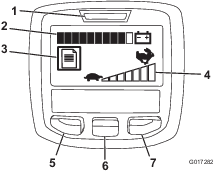
-
Power light/fault indicator—illuminates when you turn the machine on. This light also blinks when there is a machine fault.
-
Battery charge indicator—when the battery has a full charge, all of the boxes in the indicator will be filled in with black. As power is used, boxes will be filled with white starting from the right and proceeding to the left as the battery drains. When only 1 box is still black the battery pack is almost out of power; the machine enters a power reduction mode which limits the throttle speed by 25%. You should immediately proceed to charge the battery.
-
Fault log indicator—this icon indicates that there is a current fault log to review.
-
Speed control setting—the bars turn black from left to right the faster you set the speed control. When all bars are filled with white, the machine is at zero speed.
-
Menu access/back button—press this button to access the InfoCenter menus. You can also use it to back out of any menu you are currently using.
-
Down button—use this button to scroll down menus.
-
Right button—use this button to open a menu where a right arrow indicated additional content.
Note: The purpose of each button may change depending on what is required at the time. Each button has a label with an icon displaying its current function.
Using the Menus
To access the InfoCenter menu system, press the menu access button while at the main screen. This will bring you to the main menu. Refer to the following tables for a synopsis of the options available from the menus:
| Main Menu | |
| Menu Item | Description |
| Faults | The Faults menu contains a list of the recent machine faults. Refer to the Service Manual or your authorized Toro distributor for more information on the Faults menu and the information contained there. |
| Service | The Service menu contains information on the machine such as hours of use and battery usage and status. |
| Diagnostics | The Diagnostics menu lists various states that the machine currently has. You can use this to troubleshoot certain issues as it will quickly tell you which machine controls are on and which are off. |
| About | The About menu lists the model number, serial number, and software version of your machine. |
| Settings | The Settings menu allows you to customize the InfoCenter display. |
| Service Menu | |
| Menu Item | Description |
| Hours | Lists the total number of hours that the machine has been turned on. |
| Mow Time | Lists the total number of hours that the reel has been turned on. |
| Power Use | Lists the instantaneous power delivered by the battery in Watts. |
| Battery Charge | Lists the current battery charge as a percent of capacity. |
| Battery Current | Lists the instantaneous current delivered by the battery in Amps. |
| Battery Volts | Lists the battery potential in volts. |
| Energy | Lists the total energy delivered by the battery over its entire life in watt-hours. |
| Diagnostics Menu | |
| Menu Item | Description |
| Key On | Indicates whether the ignition key is on or off. |
| PBrake Latch | Indicates whether the parking-brake latch is on or off. |
| EZ Turn | Indicates whether the EZ-Turn circuit is open or closed. |
| Traction | Indicates whether the traction lever is on or off. |
| Reel Enable | Indicates whether the reel is engaged or not. |
| Throttle | Indicates the throttle control setting in Volts (used to calculate the target rpm). |
| Target rpm | Lists the desired motor rpm as indicated by the speed control setting. |
| Motor rpm | Lists the actual motor rpm. |
| 12V Supply | Lists the sensor supply voltage #1 of the controller. |
| 5V Supply | Lists the sensor supply voltage #2 of the controller. |
| CAN Bus | Lists the machine communication bus status. |
| About Menu | |
| Menu Item | Description |
| Model | Lists the model number of the machine. |
| SN | Lists the serial number of the machine. |
| S/W Rev | Lists the revision number of the machine software. |
| Settings Menu | |
| Menu Item | Description |
| Language | Use this setting to change the language used on the InfoCenter. |
| Units | Use this setting to change the units used by the InfoCenter. The menu choices are English and Metric. |
| LCD Backlight | Use this setting to increase or decrease the brightness of the LCD display. |
| LCD Contrast | Use this setting to change the contrast between the dark and light areas of the LCD display. |
Note: If you inadvertently change the language or contrast to a setting where you can no longer understand or view the display, contact your authorized Toro distributor for assistance in resetting the display.
Operating Tips
Important: Grass clippings act as a lubricant when mowing. Operating the cutting unit excessively without grass clippings can damage the cutting unit.
Preparing to Mow
Ensure that the machine is carefully adjusted and is set evenly on both sides of the reel. For the best performance and battery life, set the bedknife to have a light contact with the reel. Improper mower adjustment is magnified in the appearance of the clipped turf.
If the transport wheels are installed on your machine, perform the following steps to remove the wheels:
-
Push the kickstand down with your foot and pull up on the handle support until the kickstand has rotated forward, over center.
-
Remove the transport wheels.
-
Carefully lower the machine off the kickstand.
Mowing the Green
The green should be mowed in a straight back-and-forth direction across the green. Avoid circular mowing or turning the mower on the green, as scuffing may occur.
Turning the mower should be done off the green by raising the cutting reel (pushing the handle down) and turning on the traction drum. If you enable the EZ-Turn switch, the traction unit slows down when you raise the cutting unit making the turn more manageable, especially for novice users.
Mowing should be done at a normal walking pace. Fast speeds save very little time and result in an inferior mowing job.
To assist in maintaining a straight line across the green and to keep the machine an equal distance from the edge of the previous cut, use the alignment stripes on the grass basket (Figure 30).
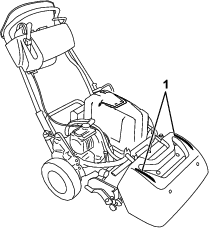
Operating the Machine in Low Light Conditions
When operating in low light conditions, use the LED Light Kit; contact your authorized Toro distributor.
Important: Do not use other light systems with this machine; they may damage the battery pack or electrical system.
Operating the Controls while Mowing
-
Start the machine, set the throttle to a reduced speed, push down on the handle to raise the cutting unit, press the operator-presence control, move the traction and reel-drive engagement lever to the FORWARD (transport) position, and transport the machine onto the collar of the green (Figure 31).
-
Move the lever to the NEUTRAL position (Figure 31).

-
Move the lever to the traction—NEUTRAL and reel drive—DISENGAGE position (Figure 31).
-
Move the lever to the traction—FORWARD and reel drive—ENGAGE position (Figure 31), increase the throttle speed until the machine is traveling at the desired ground speed, drive the machine onto the green, lower the cutting unit to the ground, and begin mowing.
Preparing to Transport the Machine after Mowing
-
Drive off the green, reduce the speed to the ZERO position, move the traction and reel drive lever to the NEUTRAL postion, and shut off the machine.
-
Empty the grass basket of clippings and install the grass basket on the mower.
After Operation
After Operation Safety
General Safety
-
Shut off the machine, remove the key (if equipped), and wait for all movement to stop before you leave the operator’s position. Allow the machine to cool before adjusting, servicing, cleaning, or storing it.
-
Clean grass and debris from the machine to help prevent fires.
-
Allow the machine to cool before storing the machine in any enclosure.
-
Do not store the machine where there is an open flame, spark, or pilot light, such as on a water heater or on other appliances.
Battery and Charger Safety
General
-
Improperly using or maintaining the battery charger could result in injury. To reduce this potential, comply with the all safety instructions.
-
Use only the supplied charger for battery charging.
-
Confirm the voltage that is available in your country before using the charger.
-
For connection to a supply not in the US, use an attachment plug adapter of the proper configuration for the power outlet, if needed.
-
Do not get the charger wet; keep it protected from rain and snow.
-
A risk of fire, electric shock, or injury may result from using an accessory not recommended or sold by Toro.
-
To reduce risk of a battery explosion, follow these instructions and the instructions for any equipment that you intend to use near the charger.
-
Batteries could emit explosive gasses if they are significantly overcharged.
Training
-
Never allow children or untrained people to operate or service the charger. Local regulations may restrict the age of the operator. The owner is responsible for training all operators and mechanics.
-
Read, understand, and follow all instructions on the charger and in the manual before operating the charger. Be familiar with the proper use of the charger.
Preparation
-
Keep bystanders and children away while charging.
-
Wear appropriate clothing while charging, including eye protection; long pants; and substantial, slip-resistant footwear.
-
Shut off the machine and wait 5 seconds until the machine has completely powered down before charging. Failure to do this may cause arcing.
-
Ensure that the area is well ventilated while charging.
-
Read and follow all precautions for charging.
-
The charger is for use only on nominal 120 and 240 VAC circuits, and is equipped with a grounding plug for 120 VAC operation. For use with 240 V circuits, contact your authorized Toro distributor for the correct power cord.
Operation
-
Do not charge a frozen battery.
-
Do not abuse the cord. Do not carry the charger by the cord or yank on the power supply cord to disconnect the charger from the receptacle. Keep the cord from heat, oil, and sharp edges.
-
Connect the charger directly to a grounding receptacle. Do not use the charger on an ungrounded outlet, even with an adaptor.
-
Do not alter the provided power cord or plug.
-
Do not alter the provided power cord or plug.
-
Avoid dropping a metal tool near or onto a battery; it might cause a spark or short-circuit an electrical part that could lead to an explosion.
-
Remove metal items such as rings, bracelets, necklaces, and watches when working with a lithium-ion battery. A lithium-ion battery can produce enough current to cause a severe burn.
-
Never operate the charger without good visibility or light.
-
Use an appropriate extension cord.
-
If the power supply cord is damaged while it is plugged in, disconnect the cord from the wall receptacle and contact an authorized Toro distributor for a replacement.
-
Unplug the charger from the electrical outlet when not in use, before moving it to another location, or prior to servicing it.
Maintenance and Storage
-
Store the charger indoors in a dry, secure place that is out of the reach of unauthorized users.
-
Do not disassemble the charger. Take the charger to an authorized Toro distributor when service or repair is required.
-
Unplug the power cord from the outlet before starting any maintenance or cleaning to reduce risk of electric shock.
-
Maintain or replace safety and instruction labels as needed.
-
Do not operate the charger with a damaged cord or plug. Replace a damaged cord or plug immediately.
-
If the charger has received an impact, been dropped, or otherwise damaged, do not use it; take it to an authorized Toro distributor.
Transporting the Machine
After mowing, transport the machine away from the job site; refer to Transporting the Machine Using Transport Wheels or Transporting the Machine Using a Trailer.
Maintaining the Lithium Ion Battery Pack
Warning
The battery pack contains high voltage, which could burn or electrocute you.
-
Do not attempt to open the battery pack.
-
Do not place anything in the connector of the battery pack other than the wire harness connector that came with the product.
-
Use extreme care when handling a battery pack with a cracked case.
-
Use only the charger designed for the battery pack.
Transporting the Battery Pack
The US Department of Transportation and international transportation authorities require that lithium ion batteries be transported using special packaging and only be transported by carriers certified to haul them. In the US, you are allowed to transport the battery when it is installed on the machine as battery powered equipment, with some regulatory requirements. Contact the US Department of Transportation or the appropriate government body in your country for detailed regulations on transportation of your eFlex or eFlex battery.
For detailed information on shipping the battery pack, refer to the Installation Instructions included with the Battery Shipping Kit. These instructions are available on www.Toro.com.
Caring for the Battery Pack
The lithium-ion-battery holds a sufficient charge to perform intended work during its life span. As time goes by, the total amount of work the battery is able to complete on a single charge gradually diminishes. The following table lists the approximate expected work that the machine should be capable of over the first 4 years of use:
| Year | Area Cut Per Full Charge |
| 1 | 3,809 m2 (41,000 ft2) |
| 2 | 3,623 m2 (39,000 ft2) |
| 3 | 3,252 m2 (35,000 ft2) |
| 4 | 3,066 m2 (33,000 ft2) |
Note: Your results may vary depending on the distance you need to transport the machine, the contact setting of the bedknife, and other factors as discussed in this section.
To achieve maximum life and use from your battery, apply the following care guidelines:
-
Do not open the battery pack. There are no user serviceable parts inside. If you open the pack you will void your warranty. The pack is protected by tamper-alerting devices.
-
Store/park the machine in a clean, dry garage or storage area, away from direct sunlight and heat sources. Do not store it in a location where the temperature drops below -30°C (-22°F) or rises above 60°C (140°F). Temperatures outside of this range will damage your battery. High temperatures during storage, especially at a high state of charge, reduces the life of the batteries.
-
When storing for more than 10 days, ensure that the machine is in a cool location, out of sunlight, and at least 50% charged.
-
If you are mowing in hot conditions or in sunlight, the battery may overheat. If this happens, a high-temperature alert will appear on the InfoCenter LCD display. In this condition, the machine no longer operates with the reel engaged and the machine slows down.
Immediately drive the machine to a cool location out of the sun, turn off the machine, and allow the battery to cool fully before resuming operation.
-
Keep the battery pack cover clean. The white color reflects sunlight and slows the heat buildup in the battery pack. A dirty cover increases the heat in the battery pack each day and reduces the energy capacity.
-
Adjust the bed knife to reel contact to be as light as possible. This reduces the power needed to run the reel and increases the amount of work the machine performs on each charge.
Understanding the Battery Charger
Refer to Figure 32 for an overview of the battery-charger displays and cords.
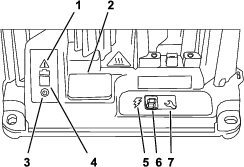

Connecting to a Power Source
To reduce the risk of electric shock, this charger has a 3-prong grounded plug (type B). If the plug does not fit into the wall receptacle, other grounded plug types are available; contact an authorized Toro distributor.
Do not change the charger or the power supply cord plug in any way.
Danger
Contact with water while operating the machine could cause electric shock, causing injury or death.
Do not handle the plug or the charger with wet hands or while standing in water.
Important: Check the power supply cord periodically for holes or cracks in the insulation. Do not use a damaged cord. Do not run the cord through standing water or wet grass.
-
Insert the charger plug on the power supply cord into the matching input power socket on the charger.
Warning
A damaged charger cord can cause an electrical shock or a fire.
Thoroughly inspect the power supply cord before using the charger. If the cord is damaged, do not operate the charger until you obtain a replacement.
-
Insert the wall plug end of the power supply cord into a grounded electrical outlet.
Charging the Battery Pack
-
Park the machine in the location designated for overnight charging.
-
Set the parking brake (Figure 18).
-
Turn the power to the eFlex off; refer to Shutting Off the Machine.
-
Disconnect the T-handle connector from the main wire harness to the main power supply connector on the battery base (Figure 33).
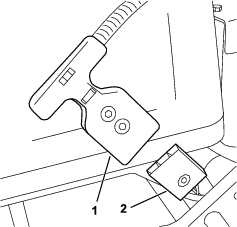
-
Clean and dry both the battery pack and charger connectors.
Important: Do not use strong solvents that will degrade the strength of the connector plastic. Do not use dielectric grease on the connector or battery contacts.
-
Align the positive connectors (marked with a “+”) of the charger connector and the power supply connector and push them together until they lock.
| Recommended charging range | 0° to 45°C (32° to 113°F) |
| Low-temperature charging range (Reduced Current) | -10° to 0°C (14° to 32°F) |
| High-temperature charging range (Reduced Current) | 45° to 60°C (113° to 140°F) |
Monitoring the Charging Process and Troubleshooting
Note: The LCD status display displays messages during the course of charging. Most are routine.
If there is a fault, the error indicator light will flash amber, or light solid red. An error message will appear in the LCD display (Figure 32) 1 digit at a time, starting with the letter E or F (for example, E-0-1-1).
To correct an error, refer to . If none of these solutions correct the issue, contact an authorized Toro distributor.
Completion of the Charging Process
When charging is complete, the battery charging indicator light shows solid green (Figure 32).
Disconnecting the Charger
-
Disconnect the charger T-handle connector from the main battery power supply connector affixed to the battery tray.
Important: Do not pull on the cables
-
Place the charger T-handle and cord in a storage position that will avoid damage.
-
Ensure that the T-handle and battery pack connectors are clean.
-
Connect the T-handle to the battery pack connector (Figure 33)
-
Turn on machine power (See the Operator’s Manual) and verify battery charge displayed on the InfoCenter matches that as stated on the charger.
Maintenance
Note: Download a free copy of the electrical schematic by visiting www.Toro.com and searching for your machine from the Manuals link on the home page.
Warning
Failing to properly maintain the machine could result in premature failure of machine systems, causing possible harm to you or bystanders.
Keep the machine well maintained and in good working order as indicated in these instructions.
Note: Determine the left and right sides of the machine from the normal operating position.
Note: Download a free copy of the electrical or hydraulic schematic by visiting www.Toro.com and searching for your machine from the Manuals link on the home page.
Caution
If you leave the key in the switch, someone could accidently start the machine and seriously injure you or other bystanders.
Remove the key from the switch and disconnect the battery before you do any maintenance.
Maintenance Safety
-
Before you leave the operator’s position, do the following:
-
Park the machine on a level surface.
-
Disengage the cutting unit(s).
-
Ensure that the traction is in neutral.
-
Engage the parking brake.
-
Shut off the machine and remove the key (if equipped).
-
Wait for all movement to stop.
-
-
Allow machine components to cool before performing maintenance.
-
If possible, do not perform maintenance while the machine is running. Keep away from moving parts.
-
If the machine must be on to perform a maintenance adjustment, keep your hands, feet, clothing, and any parts of the body away from the cutting unit, attachments, and any moving parts. Keep bystanders away.
-
Clean grass and debris from the cutting unit, drive, motor, and battery to help prevent fires.
-
Keep all parts in good working condition. Replace all worn, damaged, or missing parts and decals. Keep all hardware tight to ensure that the machine is in safe working condition.
-
Check the grass catcher components frequently and replace them when necessary.
-
To ensure safe, optimal performance of the machine, use only genuine Toro replacement parts. Replacement parts made by other manufacturers could be dangerous, and such use could void the product warranty.
-
If major repairs are ever needed or if assistance is desired, contact an authorized Toro distributor.
Recommended Maintenance Schedule(s)
| Maintenance Service Interval | Maintenance Procedure |
|---|---|
| Before each use or daily |
|
| After each use |
|
| Every 1,000 hours |
|
| Before storage |
|
| Yearly |
|
Pre-Maintenance Procedures
Disconnecting the Battery
Before performing maintenance on the machine, disconnect the machine from the battery pack by pulling the T-handle connector off the main power supply connector (Figure 34).

Lubrication
Greasing the Motor Coupler
| Maintenance Service Interval | Maintenance Procedure |
|---|---|
| Yearly |
|
Grease Type: General-purpose grease.
-
Shut off the machine and disconnect the battery pack.
-
Remove the 2 bolts that secure the motor to the transmission case (Figure 35).
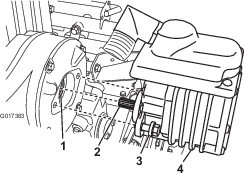
-
Pull the motor out and away from the transmission case.
-
Add 1 to 2 pumps of grease from a grease gun to the female coupler in the transmission case (Figure 35).
-
Install the motor and secure it with the 2 bolts that you removed previously. Torque the bolts to 29 to 33 N∙m (21 to 25 ft-lb).
Electrical System Maintenance
Electrical System Safety
-
Disconnect the battery before repairing the machine.
-
Charge the battery in an open, well-ventilated area, away from sparks and flames. Unplug the charger before connecting or disconnecting the battery. Wear protective clothing and use insulated tools.
Servicing the Battery Pack
The only user serviceable parts in the battery pack are the labels. If you attempt to open the main compartment of the battery pack or the master controller you will void your warranty. If you are having problems with your battery pack, contact your authorized Toro distributor for help.
Warning
The battery pack contains high voltage which could burn or electrocute you.
-
Do not attempt to open the battery pack.
-
Do not place anything in the connector of the battery pack other than the wire harness connector that came with the product.
-
Use extreme care when handling a battery pack with a cracked case.
-
Only use the charger designed for the battery pack
Shipping the Battery Pack for Service
If your battery pack requires service, contact your authorized Toro distributor for assistance. If you must ship the battery pack, obtain the Battery Shipping Kit. This kit contains the proper tape, labeling, and instructions you will need to ship the battery pack.
Important: Failure to correctly pack and label the battery pack for shipping can result in large fines. Refer to the instructions included in the Battery Shipping Kit, available for free on www.Toro.com.
Disposing of the Battery
The lithium-ion battery must be disposed of or recycled in accordance with local and federal regulations.
Maintaining the Battery Charger
Important: All electrical repairs should be performed by an authorized Toro distributor only.
The operator can perform very little maintenance other than protecting the charger from damage and weather.
Maintaining the Battery-Charger Cords
-
Clean the cords with a slightly damp cloth after each use.
-
Coil the cords when not in use.
-
Periodically examine the cords for damage, and replace them when necessary with Toro-approved parts.
Cleaning the Battery-Charger Case
Clean the case with a slightly damp cloth after each use.
Replacing Fuses
If the machine does not turn on, even after charging, check the machine fuses as follows:
-
Turn off the machine and disconnect the battery pack.
-
Remove the 8 screws securing the battery pack cover and remove the cover.
-
Check the fuses in the fuse block (Figure 36).
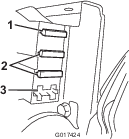
-
If any fuse is blown, replace them with a fuse of the appropriate voltage and amperage (Figure 36).
Important: All fuses on the machine are rated for 80 V. Do not use 12 V automotive fuses.
Servicing the Traction Interlock Switch
Use the following procedure if the traction-interlock switch needs adjustment or replacement.
-
Turn off the machine and disconnect the battery pack.
-
Remove the control panel.
-
Engage the traction lever.
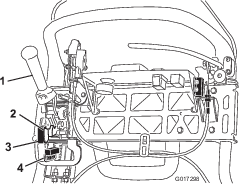
-
Loosen the interlock switch mounting fasteners (Figure 37).
-
Place a 1.6 mm (0.062 inch) thick shim between the traction lever and the interlock switch (Figure 37).
-
Tighten the interlock switch mounting fasteners. Check the gap again. The traction lever must not contact the switch.
-
Engage the traction lever and check the gap. The normal operating range is between 0.76 to 3.05 mm (0.03 to 0.12 inch). With the traction lever engaged, verify that the switch loses continuity. Replace the switch if necessary.
Servicing the Mow Sensor
-
Shut off the machine and disconnect the battery pack.
-
Remove the control panel.
-
Push the traction lever to the left and engage the mower.
-
Loosen the mow sensor mounting fasteners (Figure 37).
-
Place a 1.6 mm (0.062 inch) thick shim between the mow sensor flag and the mow sensor (Figure 37).
-
Tighten the sensor mounting fasteners. Check the gap. The flag must not contact the sensor.
-
Engage the traction lever in mowing mode and verify that the switch loses continuity. Replace the sensor if necessary.
Servicing the Brake-Interlock Switch
-
Shut off the machine and disconnect the battery pack.
-
Remove the console cover.
-
Engage the service-brake lever and engage the parking-brake latch.
-
Loosen and remove the interlock switch mounting fasteners (Figure 38).
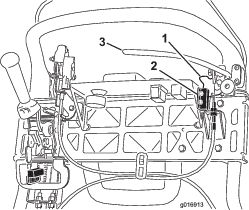
-
Place a 1.6 mm (0.062 inch) thick shim between the parking-brake latch and the interlock switch (Figure 38).
-
Install and tighten the interlock switch mounting fasteners. Check the gap. The latch must not contact the switch.
-
Engage the brake lever and rotate the latch. Verify that the switch loses continuity. Replace the switch if necessary.
Brake Maintenance
Adjusting the Service/Parking Brake
If the service/parking brake slips when operated, adjust the cable as follows:
-
Turn off the machine and disconnect the battery pack.
-
Move the service/parking brake lever to the OFF position.
-
Remove the console cover.
-
To increase the cable tension, loosen the upper cable jam nut and tighten the lower cable jam nut (Figure 38) until a force of 156 N (35 lb) applied to the brake lever handle is required to release the parking-brake latch.
Important: Do not over adjust or the brake band may drag.
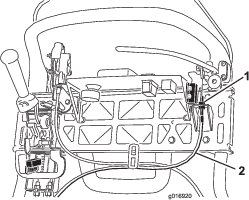
Belt Maintenance
Inspecting the Reel Drive Belt
| Maintenance Service Interval | Maintenance Procedure |
|---|---|
| Every 1,000 hours |
|
Make sure that the reel drive belt is properly tensioned to ensure proper operation of the machine and unnecessary wear.
-
Turn off the machine and disconnect the battery pack.
-
Loosen the flange bolt that secures the belt cover and remove the belt cover to expose the belt (Figure 40).
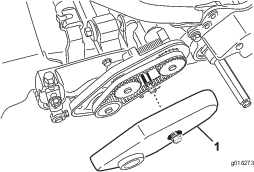
-
Adjust the belt tension by doing the following steps:
-
Loosen the bearing housing mounting nut (Figure 41).

-
Using a 16 mm (5/8 inch) wrench, rotate the bearing housing to ensure that it operates freely.
-
Clean any debris from inside the belt compartment and from around the compression spring (Figure 41).
-
Ensure that the compression spring is applying the proper tension on the belt.
-
Tighten the bearing housing mounting nut.
-
Install the belt cover.
-
Accessing the Transmission Cover Hole
Remove the rubber plug (Figure 42) from the hole in the front of the transmission if you need to access the reel clutch.
Important: Do not operate the machine without the rubber plug.
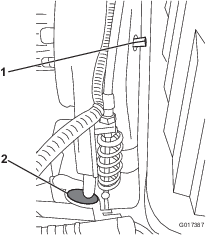
Engaging/Disengaging the Transmission-Belt Tensioner
The transmission belt is tensioned by a spring-loaded idler pulley. If you must engage or disengage the belt tension, use a 3/8-inch wrench to rotate the engage/disengage shaft (Figure 42) to the desired position. Rotating the shaft 1/4 turn (90°) clockwise disengages the idler from the belt (Figure 43).
Note: You must disengage the belt tension before removing the transmission cover.
Note: The transmission belt is properly tensioned when the alignment marks on the transmission cover and the engagement shaft are aligned.
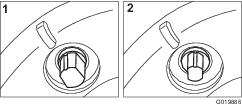
Controls System Maintenance
Adjusting the Reel Control
If the reel control does not properly engage, an adjustment is required.
-
Turn off the machine and disconnect the battery pack.
-
Ensure that the reel control is disengaged.
-
At the transmission bulkhead, adjust the reel-control cable (Figure 44), to attain a spring length of 70.6 to 72.4 mm (2.78 to 2.85 inches).
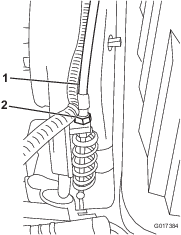
-
At the control handle bulkhead, loosen the reel-control cable until there is slack in the cable (Figure 45).
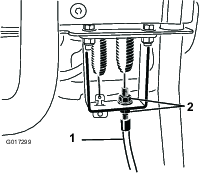
-
At the control handle bulkhead, tighten the reel-control cable enough to remove the slack from the cable without extending the spring.
-
Check the operation as follows:
-
Verify that the reel clutch teeth disengage when the clutch is released and the reel clutch teeth do not bottom out when engaged.
Note: Remove the rubber plug (Figure 42) from the hole in the front of the transmission to view reel clutch.
-
The reel stopping time must be less than 7 seconds with the reel to bedknife backed off.
-
Refer to the Service Manual or contact your authorized Toro distributor for further assistance.
-
Cutting Unit Maintenance
Blade Safety
Use care when checking the reel cutting-unit. Wear gloves and use caution when servicing the reel.
A worn or damaged blade or bedknife can break, and a piece could be thrown toward you or bystanders, resulting in serious personal injury or death.
-
Inspect the blades and bedknives periodically for excessive wear or damage.
-
Use care when checking the blades. Wear gloves and use caution when servicing them. Only replace or backlap the blades and bedknives; never straighten or weld them.
-
When servicing the blades, be aware that you can still move the blades after you disconnect the power.
Cleaning
Cleaning the Machine
| Maintenance Service Interval | Maintenance Procedure |
|---|---|
| After each use |
|
After each use, wash the machine with mild detergent and water. Do not pressure wash the machine. Avoid excessive use of water, especially near the shift-lever plate, the InfoCenter, the power center, and the machine power connector. Clean the motor to provide proper cooling during operation. Also, keep the battery pack as clean as possible so that it maintains a white color. This reflects sunlight and keeps the battery from overheating in the sun.
Important: Do not use brackish or reclaimed water to clean the machine.
Important: Always store or park the machine out of direct sunlight, as heating from the sun reduces the battery-pack life span.
Storage
Storage Safety
-
Shut off the machine, remove the key (if equipped), and wait for all movement to stop before you leave the operator’s position. Allow the machine to cool before adjusting, servicing, cleaning, or storing it.
-
Do not store the machine or fuel container where there is an open flame, spark, or pilot light, such as on a water heater or other appliance.
Storing the Machine
-
Clean the machine; refer to Cleaning the Machine.
Important: You can wash the machine with mild detergent and fresh clean water. Do not pressure-wash the machine. Avoid excessive use of water, especially near the shift-lever plate, the InfoCenter, the power center, and the machine power connector.
-
Check and tighten all fasteners. Repair or replace any part that is worn or damaged.
-
Paint all scratched or bare metal surfaces with paint available from your authorized Toro distributor.
-
For prolonged storage, follow the battery storage requirements; refer to Battery Storage Requirements.
-
Cover the machine to protect it and keep it clean.
Battery Storage Requirements
Note: You do not need to remove the battery from the machine for storage.
Refer to the temperature requirements for storage in the following table:
| Storage Conditions | Temperature Requirement |
| Normal storage conditions | -20° to 45°C (-12° to 113°F) |
| Extreme heat—1 month or less | 45° to 60°C (113° to 140°F) |
| Extreme cold—3 months or less | -30° to -20°C (-22° to -12°F) |
Important: Temperatures outside of this range will damage your battery.The temperature that the battery are stored at will affect their long-term life. Storage for long periods of time at extreme temperatures will reduce the battery life. Store the machine in a cool (not below freezing) location.
-
Before you store the machine, charge or discharge the battery between 40% to 60% (50.7V to 52.1V).
Note: A 50% charge is optimal to ensure a maximum battery life. When the battery is charged to 100% before storage, the battery life shortens.If you anticipate that the machine will be stored for a longer period of time, charge the battery to around 60%.
-
For every 6 months of storage, check the battery-charge level and ensure that it is between 40% to 60%. If the charge is below 40%, charge the battery between 40% to 60%.
-
You can use a multimeter to check the charge level when the machine is off. Refer to the following table for the amount of voltage that is equal to the charge level:
Voltage Charge Level 52.1V 60% 51.4V 50% 50.7V 40% -
After charging the battery, disconnect the battery charger from power. Disconnect the power connector during storage to minimize the discharging of the battery.
-
If you leave the charger on the machine, it will shut off after the battery is fully charged and does not turn back on unless the charger is disconnected and reconnected.
Storing the Charger
-
Complete the procedure for Disconnecting the Charger.
-
Disconnect the power supply cord from the charger and coil it securely.
-
Examine the power supply cord thoroughly for signs of wear or damage. Replace it if it is worn or damaged.
-
Examine the charger thoroughly for worn, loose, or damaged parts. To repair or replace parts, contact your authorized Toro distributor for assistance.
-
Store the charger with the power supply cord in a clean, dry place where it will not be bumped or damaged and not exposed to caustic fumes.
Removing the Machine from Storage
-
Turn off and disconnect the charger from the machine.
-
Connect the T-handle connector to the main power connector.
-
Turn on the machine and wait for 20 seconds.
Troubleshooting
| Problem | Possible Cause | Corrective Action |
|---|---|---|
| Code E-0-0-1, or E-0-4-7 |
|
|
| Code E-0-0-4 |
|
|
| Code E-0-0-7 |
|
|
| Code E-0-1-2 |
|
|
| Code E-0-2-3 |
|
|
| Code E-0-2-4 |
|
|
| Code E-0-2-5 |
|
|
| Code E-0-3-7 |
|
|
| Code E-0-2-9, E-0-3-0, E-0-3-2, E-0-4-6, or E-0-6-0 |
|
|
| Problem | Possible Cause | Corrective Action |
|---|---|---|
| F-0-0-1, F-0-0-2, F-0-0-3, F-0-0-4, F-0-0-5, F-0-0-6, or F-0-0-7 |
|
|
